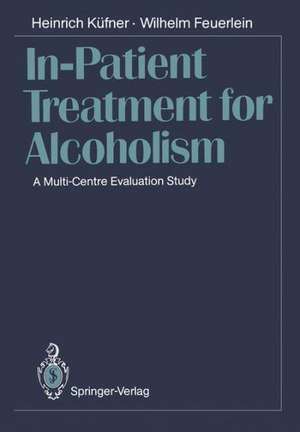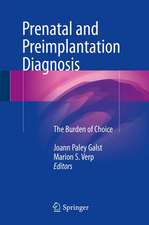In-Patient Treatment for Alcoholism: A Multi-Centre Evaluation Study
Klaus Antons Autor Heinrich Küfner Traducere de F. K. H. Wagstaff Dieter Fiedel Autor Wilhelm Feuerlein Thomas Flohrschütz, Erwin Hansert, Manfred Huberen Limba Engleză Paperback – 16 dec 2011
Preț: 724.50 lei
Preț vechi: 762.64 lei
-5% Nou
Puncte Express: 1087
Preț estimativ în valută:
138.64€ • 148.25$ • 115.59£
138.64€ • 148.25$ • 115.59£
Carte tipărită la comandă
Livrare economică 17 aprilie-01 mai
Preluare comenzi: 021 569.72.76
Specificații
ISBN-13: 9783642743900
ISBN-10: 3642743900
Pagini: 400
Ilustrații: XIV, 381 p.
Dimensiuni: 170 x 242 x 21 mm
Greutate: 0.64 kg
Ediția:Softcover reprint of the original 1st ed. 1989
Editura: Springer Berlin, Heidelberg
Colecția Springer
Locul publicării:Berlin, Heidelberg, Germany
ISBN-10: 3642743900
Pagini: 400
Ilustrații: XIV, 381 p.
Dimensiuni: 170 x 242 x 21 mm
Greutate: 0.64 kg
Ediția:Softcover reprint of the original 1st ed. 1989
Editura: Springer Berlin, Heidelberg
Colecția Springer
Locul publicării:Berlin, Heidelberg, Germany
Public țintă
ResearchCuprins
1 Introduction.- 1.1 Aim of the Study.- 1.2 Review of the Literature.- 2 Method.- 2.1 Basic Model.- 2.2 Structure of the Study.- 2.3 Selection of Patients.- 2.4 Patient Variables.- 2.5 Assessing the Outcome of Treatment.- 2.6 Study Procedure.- 2.7 Data Protection.- 2.8 Data Evaluation.- 3 Treatment Centres.- 3.1 Description.- 3.2 Factors in the Therapeutic Atmosphere.- 3.3 Summary.- 4 Admission Data.- 4.1 Data Collection.- 4.2 Sociodemographic Data.- 4.3 Use of Addictive Substances.- 4.4 Personality and Social Behaviour.- 4.5 Physical Condition.- 4.6 Previous Treatment for Alcoholism.- 4.7 Attitudes to Treatment (EZB).- 4.8 Life Events (LEL).- 4.9 Summary.- 5 Discharge Data.- 5.1 Data Collection.- 5.2 Sociodemographic Data.- 5.3 Behaviour and Symptoms During Treatment.- 5.4 Personality Changes.- 5.5 Summary.- 6 Six-Month Follow-Up.- 6.1 Data Collection.- 6.2 Sociodemographic Data.- 6.3 Use of Addictive Substances.- 6.4 Personality Changes.- 6.5 Physical Condition.- 6.6 Life Events.- 6.7 Treatment During the First 6 Months After Discharge.- 6.8 Comparison of Some Outcome Criteria.- 6.9 Summary.- 7 Eighteen-Month Follow-Up.- 7.1 Data Collection.- 7.2 Sociodemographic Data.- 7.3 Use of Addictive Substances.- 7.4 Personality and Social Behaviour.- 7.5 Physical Condition and Complaints.- 7.6 Life Events.- 7.7 Treatment During the Follow-Up Period.- 7.8 Comparison of Different Outcome Criteria.- 7.9 Summary.- 8 Data from Health and Pension Insurance Institutions.- 8.1 Health Insurance Companies.- 8.2 Pension Insurance Institutions.- 8.3 Summary.- 9 Reliability and Validity of Data.- 9.1 Heterogeneity of Data.- 9.2 Results.- 9.3 Summary.- 10 Changes Over the Course of the Study.- 10.1 Alcohol Abstinence.- 10.2 Marital Status, Living Arrangements and Work.- 10.3 Changes In andInteractions Between Outcome Criteria.- 10.4 Changes in Personality and Social Behaviour.- 10.5 Drop-Outs from Treatment, Length of Treatment and Outcome.- 10.6 Summary.- 11 Patients’ Attitudes to and Experiences of Treatment.- 11.1 Attitudes to Treatment (EZB).- 11.2 Patients’ Experiences of Therapy (TEL).- 11.3 Correlation Between EZB and TEL.- 11.4 Summary.- 12 Patient Variables as Prognostic Factors.- 12.1 Introduction.- 12.2 Method.- 12.3 Prognostic Factors for Drinking Behaviour.- 12.4 Prognostic Factors for Other Outcome Criteria.- 12.5 Analysis of Variables and Constructs of Special Clinical Relevance.- 12.6 Prognostic Significance of Dropping Out.- 12.7 Summary.- 13 Treatment Variables.- 13.1 Introduction.- 13.2 Grouping of Treatment Variables and Treatment Centres.- 13.3 Treatment Variables and Outcome.- 13.4 Effect of the Length of Treatment.- 13.5 Effects of After-Care in the Follow-Up Period.- 13.6 Summary.- 14 Indication.- 14.1 Introduction.- 14.2 Indication for Length of Treatment.- 14.3 Method.- 14.4 Results for Men.- 14.5 Indication Model for Men.- 14.6 Results for Women.- 14.7 Indication Model for Women.- 14.8 Prognosis and Indication.- 14.9 Summary.- 15 Other Factors Influencing Outcome.- 15.1 Influence Factors in After-Care and After-Treatment.- 15.2 Influence Factors in the Social Environment.- 15.3 Network of Influence Factors and Treatment Outcome.- 15.4 Summary.- 16 Discussion.- 16.1 Methodology.- 16.2 Results of the Individual Data Collections.- 16.3 Patients’ Attitudes to and Experiences of Treatment.- 16.4 Prognosis.- 16.5 Treatment Variables.- 16.6 Indication.- 16.7 Influence Factors After Index Treatment.- References.- Appendices.














